Techno-Economic Assessment of Molten Salt-Based Concentrated Solar Power: Case Study of Linear Fresnel Reflector with a Fossil Fuel Backup under Saudi Arabia’s Climate Conditions
Abstract
:1. Background
1.1. Molten Salt
1.2. Thermal Energy Storage
1.3. Solar Multiple Thermal Energy Storage Parametric Analysis
2. Aim and Objectives
- Determine optimal SM and TES sizes for the efficient operation of the LFR solar field;
- Integrate a fossil fuel backup system to enhance thermal performance and assess its impact on overall energy production;
- Conduct a detailed investigation into the annual and daily thermal performance of the LFR power plant under varying conditions;
- Minimize energy production costs associated with the LFR power plant while ensuring continuous operational functionality;
- Provide multiple optimum configurations for the solar field, TES, and FF backup sizes to achieve the lowest LCOE and highest thermal performance;
- Offer deeper insights into the utilization of molten salt with a large TES system and the use of a natural gas backup, particularly in climates with specific environmental and meteorological characteristics.
3. Material and Methods
3.1. Geographical Location for the Analysis
3.2. Off-Design Model Description
3.3. Mathematical Description
3.3.1. Simulation Tool
3.3.2. Incident Angel Modifier Method
3.3.3. Technical Performance Model
3.3.4. Thermal Energy Storage System
3.3.5. Economic Analysis
3.3.6. Environmental Analysis
4. Result and Discussion
4.1. Model Validation
4.2. Techno-Economic Performance
4.3. Thermal Energy Storage and Solar Multiple Optimization
4.4. Power Plant Thermal Performance
4.5. Backup System Sensitivity Analysis
4.6. Environmental Impact
5. Conclusions
Author Contributions
Funding
Data Availability Statement
Acknowledgments
Conflicts of Interest
Nomenclature
| AEG | Annual energy generation |
| CAPEX | Capital expenditure |
| CF | Capacity factor |
| CLFR | Compact linear Fresnel reflector |
| CSP | Concentrated solar power |
| DNI | Direct normal irradiance |
| DOE | Department of Energy |
| DSG | Direct steam generation |
| FF | Fossil fuel |
| FFF | Fossil fuel fraction |
| GHG | Greenhouse gases |
| HTF | Heat transfer fluid |
| IAM | Incident angel modifier |
| IRENA | International Renewable Energy Agency |
| IRR | Internal rate of return |
| LCOE | Levelized cost of electricity |
| LFR | Linear Fresnel reflector |
| MENA | Middle East and North Africa |
| MS | Molten salt |
| NG | Natural gas |
| NPV | Net present value |
| NREL | National Renewable Energy Laboratory |
| OPEX | Operational and maintenance expenditure |
| PB | Power block |
| PSD | Parabolic sterling dish |
| PTC | Parabolic trough collector |
| PV | Photovoltaics |
| RES | Renewable energies |
| SAM | System advisor model |
| SF | Solar field |
| SM | Solar multiple |
| SPT | Solar power tower |
| TES | Thermal energy storage |
| Megawatt of thermal energy | |
| GW | Gigawatt of electricity |
| Solar radiation unit per day | |
| Mbbl/d | Million oil barrels per day |
| MMBtu | Million metric british unit |
| Megawatt of electricity | |
| Tonne CO₂ eq/MWh | Tonne of CO₂ equivalent per megawatt hour |
| US Cent/kWh | Unit price of electricity |
References
- Dieckmann, S.; Dersch, J.; Giuliano, S.; Puppe, M.; Lüpfert, E.; Hennecke, K.; Pitz-Paal, R.; Taylor, M.; Ralon, P. LCOE reduction potential of parabolic trough and solar tower CSP technology until 2025. AIP Conf. Proc. 2017, 1850, 160004. [Google Scholar]
- Yao, Y.; Xu, J.H.; Sun, D.Q. Untangling global levelised cost of electricity based on multi-factor learning curve for renewable energy: Wind, solar, geothermal, hydropower and bioenergy. J. Clean. Prod. 2021, 285, 124827. [Google Scholar] [CrossRef]
- Musi, R.; Grange, B.; Sgouridis, S.; Guedez, R.; Armstrong, P.; Slocum, A.; Calvet, N. Techno-economic analysis of concentrated solar power plants in terms of levelized cost of electricity. AIP Conf. Proc. 2017, 1850, 160018. [Google Scholar]
- Aly, A.; Bernardos, A.; Fernandez-Peruchena, C.M.; Jensen, S.S.; Pedersen, A.B. Is Concentrated Solar Power (CSP) a feasible option for Sub-Saharan Africa?: Investigating the techno-economic feasibility of CSP in Tanzania. Renew. Energy 2019, 135, 1224–1240. [Google Scholar] [CrossRef]
- International Renewable Energy Agency. Renewable Power Generation Costs in 2020; International Renewable Energy Agency: Masdar City, United Arab Emirates, 2020. [Google Scholar]
- British Petroleum. bp Energy Outlook 2023 Edition 2023 Explores the Key Trends and Uncertainties; BP p.l.c.: London, UK, 2023; pp. 1–53. [Google Scholar]
- Palacios, A.; Barreneche, C.; Navarro, M.E.; Ding, Y. Thermal energy storage technologies for concentrated solar power—A review from a materials perspective. Renew. Energy 2020, 156, 1244–1265. [Google Scholar] [CrossRef]
- Balghouthi, M.; Trabelsi, S.E.; Amara, M.B.; Bel, A.; Ali, H. Potential of concentrating solar power (CSP) technology in Tunisia and the possibility of interconnection with Europe. Renew. Sustain. Energy Rev. 2016, 56, 1227–1248. [Google Scholar] [CrossRef]
- Desai, N.B.; Bandyopadhyay, S. Line-focusing concentrating solar collector-based power plants: A review. Clean Technol. Environ. Policy 2017, 19, 9–35. [Google Scholar] [CrossRef]
- Kassem, A.; Al-Haddad, K.; Komljenovic, D. Concentrated solar thermal power in Saudi Arabia: Definition and simulation of alternative scenarios. Renew. Sustain. Energy Rev. 2017, 80, 75–91. [Google Scholar] [CrossRef]
- Mills, D.R.; Morrison, G.L. Compact linear fresnel reflector solar thermal powerplants. Sol. Energy 2000, 68, 263–283. [Google Scholar] [CrossRef]
- Boito, P.; Grena, R. Optimization of the geometry of Fresnel linear collectors. Sol. Energy 2016, 135, 479–486. [Google Scholar] [CrossRef]
- Abbas, R.; Muñoz-Antón, J.; Valdés, M.; Martínez-Val, J.M. High concentration linear Fresnel reflectors. Energy Convers. Manag. 2013, 72, 60–68. [Google Scholar] [CrossRef]
- Ladkany, S.; Culbreth, W.; Loyd, N. Molten Salts and Applications III: Worldwide Molten Salt Technology Developments in Energy Production and Storage. J. Energy Power Eng. 2018, 12, 533–544. [Google Scholar]
- Arias, I.; Cardemil, J.; Zarza, E.; Valenzuela, L.; Escobar, R. Latest developments, assessments and research trends for next generation of concentrated solar power plants using liquid heat transfer fluids. Renew. Sustain. Energy Rev. 2022, 168, 112844. [Google Scholar] [CrossRef]
- Bellos, E.; Mathioulakis, E.; Tzivanidis, C.; Belessiotis, V.; Antonopoulos, K.A. Experimental and numerical investigation of a linear Fresnel solar collector with flat plate receiver. Energy Convers. Manag. 2016, 130, 44–59. [Google Scholar] [CrossRef]
- Aljudaya, A.; Ingham, D.; Ma, L.; Hughes, K.; Pourkashanian, M. A Comparative Study of the Techno-Economic Performance of the Linear Fresnel Reflector Using Direct and Indirect Steam Generation: A Case Study under High Direct Normal Irradiance. Int. J. Energy Power Eng. 2023, 17, 255–261. [Google Scholar]
- Ibrahim, A.; Peng, H.; Riaz, A.; Basit, M.A.; Rashid, U.; Basit, A. Molten salts in the light of corrosion mitigation strategies and embedded with nanoparticles to enhance the thermophysical properties for CSP plants. Sol. Energy Mater. Sol. Cells 2021, 219, 110768. [Google Scholar] [CrossRef]
- Pan, C.A.; Ferruzza, D.; Guédez, R.; Dinter, F.; Laumert, B.; Haglind, F. Identification of optimum molten salts for use as heat transfer fluids in parabolic trough CSP plants. A techno-economic comparative optimization. AIP Conf. Proc. 2018, 2033, 030012. [Google Scholar]
- Fernández, A.G.; Cortes, M.; Fuentealba, E.; Pérez, F.J. Corrosion properties of a ternary nitrate/nitrite molten salt inconcentrated solar technology. Renew. Energy 2015, 80, 177–183. [Google Scholar] [CrossRef]
- Vignarooban, K.; Xu, X.; Arvay, A.; Hsu, K.; Kannan, A.M. Heat transfer fluids for concentrating solar power systems—A review. Appl. Energy 2015, 146, 383–396. [Google Scholar] [CrossRef]
- Hinkley, J.T.; Hayward, J.A.; Curtin, B.; Wonhas, A.; Boyd, R.; Grima, C.; Tadros, A.; Hall, R.; Naicker, K. An analysis of the costs and opportunities for concentrating solar power in Australia. Renew. Energy 2013, 57, 653–661. [Google Scholar] [CrossRef]
- Mihoub, S. Design, economic, and environmental assessments of linear Fresnel solar power plants. Environ. Prog. Sustain. Energy 2020, 39, 1–16. [Google Scholar] [CrossRef]
- Abbas, R.; Montes, M.J.; Piera, M.; Martínez-Val, J.M. Solar radiation concentration features in Linear Fresnel Reflector arrays. Energy Convers. Manag. 2012, 54, 133–144. [Google Scholar] [CrossRef]
- Santos, J.J.C.S.; Palacio, J.C.E.; Reyes, A.M.M.; Carvalho, M.; Freire, A.J.R.; Barone, M.A. Concentrating Solar Power. Adv. Renew. Energies Power Technol. 2018, 1, 373–402. [Google Scholar]
- Morin, G.; Dersch, J.; Platzer, W.; Eck, M.; Häberle, A. Comparison of Linear Fresnel and Parabolic Trough Collector power plants. Sol. Energy 2012, 86, 1–12. [Google Scholar] [CrossRef]
- Marugán-Cruz, C.; Serrano, D.; Gómez-Hernández, J.; Sánchez-Delgado, S. Solar multiple optimization of a DSG linear Fresnel power plant. Energy Convers. Manag. 2019, 184, 571–580. [Google Scholar] [CrossRef]
- U.S. Department of Energy NREL—National Renewable Energy Laboratory. 2014. Available online: http://www.nrel.gov/ (accessed on 3 February 2020).
- Bhandari, B.; Lee, K.T.; Lee, G.Y.; Cho, Y.M.; Ahn, S.H. Optimization of hybrid renewable energy power systems: A review. Int. J. Precis. Eng. Manuf. Green Technol. 2015, 2, 99–112. [Google Scholar] [CrossRef]
- Hakkarainen, E.; Kannari, L. Dynamic Modelling of Concentrated Solar Field for Thermal Energy Storage Integration. In Proceedings of the 9th International Renewable Energy Storage Conference (IRES 2015), Dusseldorf, Germany, 9–11 March 2015. [Google Scholar]
- Montes, M.J.J.; Abánades, A.; Martínez-Val, J.M.M.; Valdés, M. Solar multiple optimization for a solar-only thermal power plant, using oil as heat transfer fluid in the parabolic trough collectors. Sol. Energy 2009, 83, 2165–2176. [Google Scholar] [CrossRef]
- Sultan, A.J.; Hughes, K.J.; Ingham, D.B.; Ma, L.; Pourkashanian, M. Techno-economic competitiveness of 50 MW concentrating solar power plants for electricity generation under Kuwait climatic conditions. Renew. Sustain. Energy Rev. 2020, 134, 110342. [Google Scholar] [CrossRef]
- Alfailakawi, M.S.; Michailos, S.; Ingham, D.B.; Hughes, K.J.; Ma, L.; Pourkashanian, M. Multi-temporal resolution aerosols impacted techno-economic assessment of concentrated solar power in arid regions: Case study of solar power tower in Kuwait. Sustain. Energy Technol. Assess. 2022, 52, 102324. [Google Scholar] [CrossRef]
- Kumar, S.; Agarwal, A.; Kumar, A. Financial viability assessment of concentrated solar power technologies under Indian climatic conditions. Sustain. Energy Technol. Assess. 2020, 43, 100928. [Google Scholar] [CrossRef]
- Xu, X.; Vignarooban, K.; Xu, B.; Hsu, K.; Kannan, A.M. Prospects and problems of concentrating solar power technologies for power generation in the desert regions. Renew. Sustain. Energy Rev. 2016, 53, 1106–1131. [Google Scholar] [CrossRef]
- AREVA. AREVA Delivers the Most Cost-Effective and Land-Efficient CSP Technology-in the Most Environmentally Responsible and Water-Conservative Manner; AREVA: Paris, France, 2011. [Google Scholar]
- Cspfocus. Project Database. 2017. Available online: http://www.cspfocus.cn/en/study/detail_94.htm (accessed on 12 February 2020).
- Xu, Y.; Pei, J.; Yuan, J.; Zhao, G. Concentrated solar power: Technology, economy analysis, and policy implications in China. Environ. Sci. Pollut. Res. 2022, 29, 1324–1337. [Google Scholar] [CrossRef]
- Fernández, A.G.; Gomez-Vidal, J.; Oró, E.; Kruizenga, A.; Solé, A.; Cabeza, L.F. Mainstreaming commercial CSP systems: A technology review. Renew. Energy 2019, 140, 152–176. [Google Scholar] [CrossRef]
- Hafez, A.A.; Nassar, Y.F.; Hammdan, M.I.; Alsadi, S.Y. Technical and Economic Feasibility of Utility-Scale Solar Energy Conversion Systems in Saudi Arabia. Iran. J. Sci. Technol. Trans. Electr. Eng. 2020, 44, 213–225. [Google Scholar] [CrossRef]
- Amran, Y.H.A.; Amran, Y.H.M.; Alyousef, R.; Alabduljabbar, H. Renewable and sustainable energy production in Saudi Arabia according to Saudi Vision 2030; Current status and future prospects. J. Clean. Prod. 2020, 247, 119602. [Google Scholar] [CrossRef]
- Alami, A.H.; Olabi, A.; Mdallal, A.; Rezk, A.; Radwan, A.; Rahman, S.M.A.; Shah, S.K.; Abdelkareem, M.A. Concentrating solar power (CSP) technologies: Status and analysis. Int. J. Thermofluids 2023, 18, 100340. [Google Scholar] [CrossRef]
- SOLARGIS. Global Solar Atlas 2.0; The World Bank: Washington, DC, USA, 2019. [Google Scholar]
- AlYahya, S.; Irfan, M.A. Analysis from the new solar radiation Atlas for Saudi Arabia. Sol. Energy 2016, 130, 116–127. [Google Scholar] [CrossRef]
- Alyahya, S.; Irfan, M.A. The techno-economic potential of Saudi Arabia’s solar industry. Renew. Sustain. Energy Rev. 2016, 55, 697–702. [Google Scholar] [CrossRef]
- Purohit, I.; Purohit, P.; Shekhar, S. Evaluating the potential of concentrating solar power generation in Northwestern India. Energy Policy 2013, 62, 157–175. [Google Scholar] [CrossRef]
- Wagner, M.J.; Zhu, G. A direct-steam linear fresnel performance model for NREL’s system advisor model. In Proceedings of the ASME 2012 6th International Conference on Energy Sustainability collocated with the ASME 2012 10th International Conference on Fuel Cell Science, Engineering and Technology, San Diego, CA, USA, 23–26 July 2012; pp. 459–468. [Google Scholar]
- Yilmazoglu, M.Z. Effects of the selection of heat transfer fluid and condenser type on the performance of a solar thermal power plant with technoeconomic approach. Energy Convers. Manag. 2016, 111, 271–278. [Google Scholar] [CrossRef]
- Kuravi, S.; Trahan, J.; Goswami, D.Y.; Rahman, M.M.; Stefanakos, E.K. Thermal energy storage technologies and systems for concentrating solar power plants. Prog. Energy Combust. Sci. 2013, 39, 285–319. [Google Scholar] [CrossRef]
- Islam, M.T.; Huda, N.; Abdullah, A.B.; Saidur, R. A comprehensive review of state-of-the-art concentrating solar power (CSP) technologies: Current status and research trends. Renew. Sustain. Energy Rev. 2018, 91, 987–1018. [Google Scholar] [CrossRef]
- METEONORM. Weather Data for Any Location on Earth. Available online: https://meteonorm.com/ (accessed on 25 September 2022).
- Soomro, M.I.; Mengal, A.; Memon, Y.A.; Khan, M.W.A.; Shafiq, Q.N.; Mirjat, N.H. Performance and economic analysis of concentrated solar power generation for Pakistan. Processes 2019, 7, 575. [Google Scholar] [CrossRef]
- Klein, S.J.W.; Rubin, E.S. Life cycle assessment of greenhouse gas emissions, water and land use for concentrated solar power plants with different energy backup systems. Energy Policy 2013, 63, 935–950. [Google Scholar] [CrossRef]
- Bishoyi, D.; Sudhakar, K. Modeling and performance simulation of 100 MW LFR based solar thermal power plant in Udaipur India. Resour. Technol. 2017, 3, 365–377. [Google Scholar] [CrossRef]
- Enriquez, L.C.; Antón, J.M.; Martínez-Val, J.M. Peñalosa SolarPaces 2013: Innovations on direct steam generation in linear fresnel collectors. In Proceedings of the SolarPACES 2013, Las Vegas, NV, USA, 17–20 September 2013. [Google Scholar]
- Kurup, P.; Turchi, C.S. Parabolic Trough Collector Cost Update for the System Advisor Model (SAM); Technical Report NREL/TP-6A20-65228; National Renewable Energy Laboratory: Golden, CO, USA, 2015; pp. 1–40. [Google Scholar]
- SCHOTT. SCHOTT PTR 70 Receiver; SCHOTT: Mainz, Germany, 1992. [Google Scholar]
- Ghodbane, M.; Boumeddane, B.; Said, Z.; Bellos, E. A numerical simulation of a linear Fresnel solar reflector directed to produce steam for the power plant. J. Clean. Prod. 2019, 231, 494–508. [Google Scholar] [CrossRef]
- Zhu, G.; Wendelin, T.; Wagner, M.J.; Kutscher, C. History, current state, and future of linear Fresnel concentrating solar collectors. Sol. Energy 2014, 103, 639–652. [Google Scholar] [CrossRef]
- Montes, M.J.; Abbas, R.; Muñoz, M.; Muñoz-Antón, J.; Martínez-Val, J.M. Advances in the linear Fresnel single-tube receivers: Hybrid loops with non-evacuated and evacuated receivers. Energy Convers. Manag. 2017, 149, 318–333. [Google Scholar] [CrossRef]
- Barbero, R.; Rovira, A.; Montes, M.J.; Val, J.M.M. A new approach for the prediction of thermal efficiency in solar receivers. Energy Convers. Manag. 2016, 123, 498–511. [Google Scholar] [CrossRef]
- Burkholder, F.; Kutscher, C. Heat Loss Testing of Schott’s 2008 PTR70 Parabolic trough Receiver; Technical report NREL/TP-550-45633; National Renewable Energy Laboratory: Golden, CO, USA, 2009. [Google Scholar]
- Blair, N.; DiOrio, N.; Freeman, J.; Gilman, P.; Janzou, S.; Neises, T.; Wagner, M. System Advisor Model (SAM) General Description; No. NREL/TP-6A20-70414; National Renewable Energy Laboratory: Golden, CO, USA, 2018. [Google Scholar]
- Ezeanya, E.K.; Massiha, G.H.; Simon, W.E.; Raush, J.R.; Chambers, T.L. System advisor model (SAM) simulation modelling of a concentrating solar thermal power plant with comparison to actual performance data. Cogent Eng. 2018, 5, 1524051. [Google Scholar] [CrossRef]
- Ho, C.K. Software and Codes for Analysis of Concentrating Solar Power Technologies; Contract; Sandia National Laboratories (SNL): Albuquerque, NM, USA; Livermore, CA, USA, 2008. [Google Scholar]
- Tozzi, P.; Jo, J.H. A comparative analysis of renewable energy simulation tools: Performance simulation model vs. system optimization. Renew. Sustain. Energy Rev. 2017, 80, 390–398. [Google Scholar] [CrossRef]
- Bellos, E.; Tzivanidis, C. Development of analytical expressions for the incident angle modifiers of a linear Fresnel reflector. Sol. Energy 2018, 173, 769–779. [Google Scholar] [CrossRef]
- Hertel, J.D.; Martinez-Moll, V.; Pujol-Nadal, R. Estimation of the influence of different incidence angle modifier models on the biaxial factorization approach. Energy Convers. Manag. 2015, 106, 249–259. [Google Scholar] [CrossRef]
- Montes, M.J.; Rubbia, C.; Abbas, R.; Martínez-Val, J.M. A comparative analysis of configurations of linear fresnel collectors for concentrating solar power. Energy 2014, 73, 192–203. [Google Scholar] [CrossRef]
- Said, Z.; Ghodbane, M.; Hachicha, A.A.; Boumeddane, B. Optical performance assessment of a small experimental prototype of linear Fresnel reflector. Case Stud. Therm. Eng. 2019, 16, 100541. [Google Scholar] [CrossRef]
- Rungasamy, A.E.; Craig, K.J.; Meyer, J.P. Comparative study of the optical and economic performance of etendue-conserving compact linear Fresnel reflector concepts. Sol. Energy 2019, 181, 95–107. [Google Scholar] [CrossRef]
- Bauer, T.; Odenthal, C.; Bonk, A. Molten Salt Storage for Power Generation. Chem. Ing. Tech. 2021, 93, 534–546. [Google Scholar] [CrossRef]
- Alshammari, Y.M. Scenario analysis for energy transition in the chemical industry: An industrial case study in Saudi Arabia. Energy Policy 2021, 150, 112128. [Google Scholar] [CrossRef]
- Craig, T. Parabolic Trough Reference Plant for Cost Modeling with the Solar Advisor Model (SAM); NREL/TP-550-47605; National Renewable Energy Laboratory: Golden, CO, USA, 2010; p. 112. [Google Scholar]
- Poghosyan, V.; Hassan, M.I. Techno-economic assessment of substituting natural gas based heater with thermal energy storage system in parabolic trough concentrated solar power plant. Renew. Energy 2015, 75, 152–164. [Google Scholar] [CrossRef]
- Zhao, Z.Y.; Chen, Y.L.; Thomson, J.D. Levelized cost of energy modeling for concentrated solar power projects: A China study. Energy 2017, 120, 117–127. [Google Scholar] [CrossRef]
- Whitaker, M.B.; Heath, G.A.; Burkhardt, J.J.; Turchi, C.S. Life cycle assessment of a power tower concentrating solar plant and the impacts of key design alternatives. Environ. Sci. Technol. 2013, 47, 5896–5903. [Google Scholar] [CrossRef] [PubMed]
- SolarPACES. Concentrating Solar Power Projects; National Renewable Energy Laboratory: Golden, CO, USA, 2021. Available online: https://solarpaces.nrel.gov/ (accessed on 21 October 2023).
- Nassar, Y.F.; Alsadi, S.Y.; El-Khozondar, H.J.; Ismail, M.S.; Al-Maghalseh, M.; Khatib, T.; Sa’ed, J.A.; Mushtaha, M.H.; Djerafi, T. Design of an isolated renewable hybrid energy system: A case study. Mater. Renew. Sustain. Energy 2022, 11, 225–240. [Google Scholar] [CrossRef]
- Boukelia, T.E.; Mecibah, M.S.; Kumar, B.N.; Reddy, K.S. Optimization, selection and feasibility study of solar parabolic trough power plants for Algerian conditions. Energy Convers. Manag. 2015, 101, 450–459. [Google Scholar] [CrossRef]
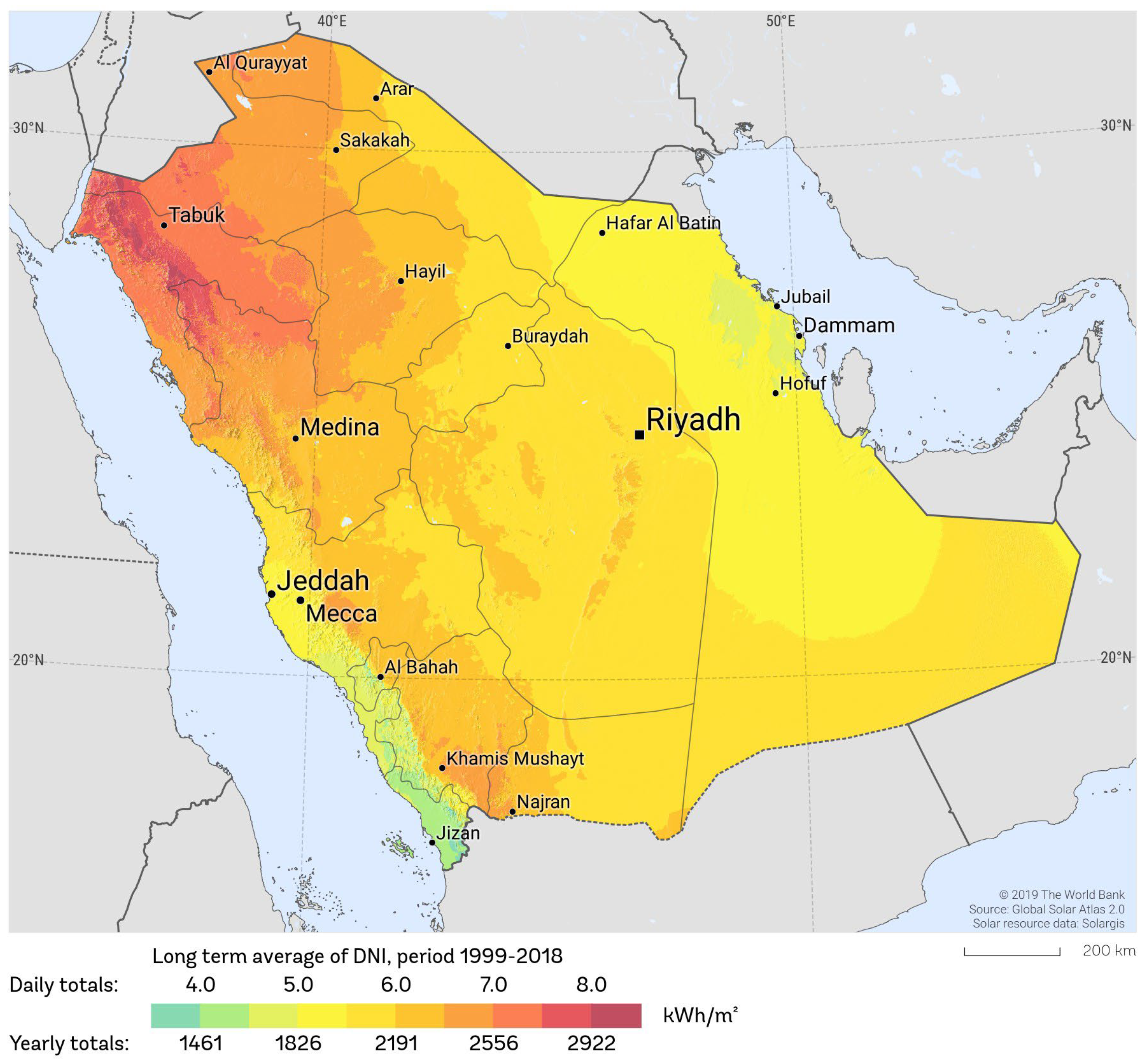
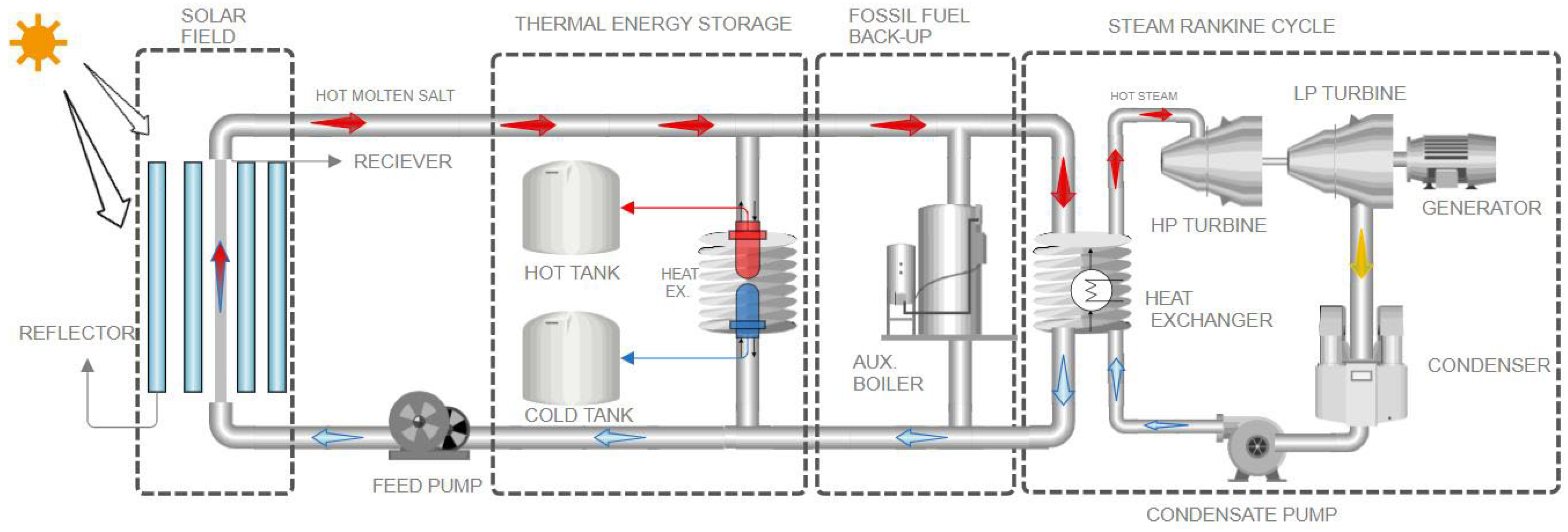
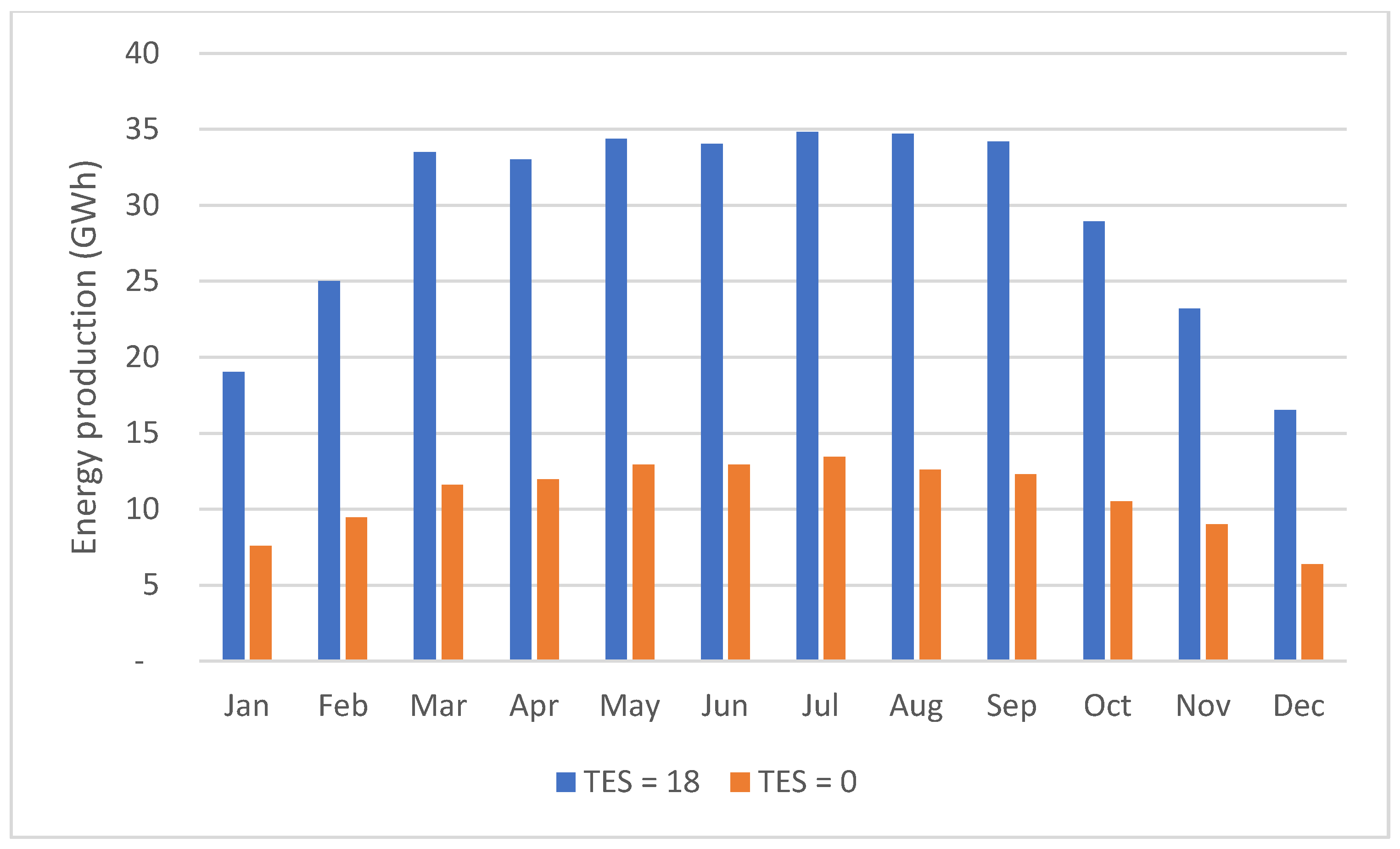

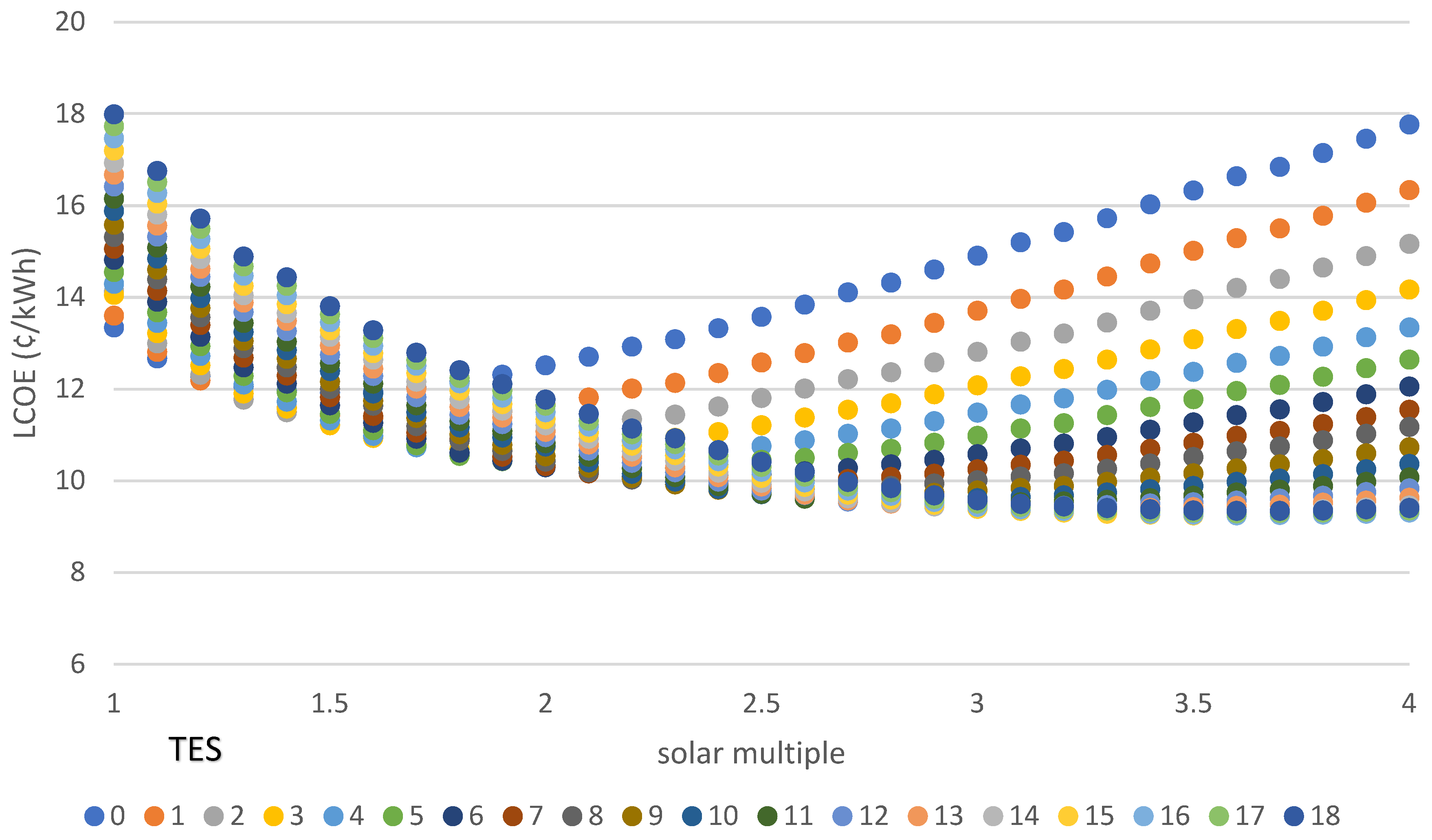
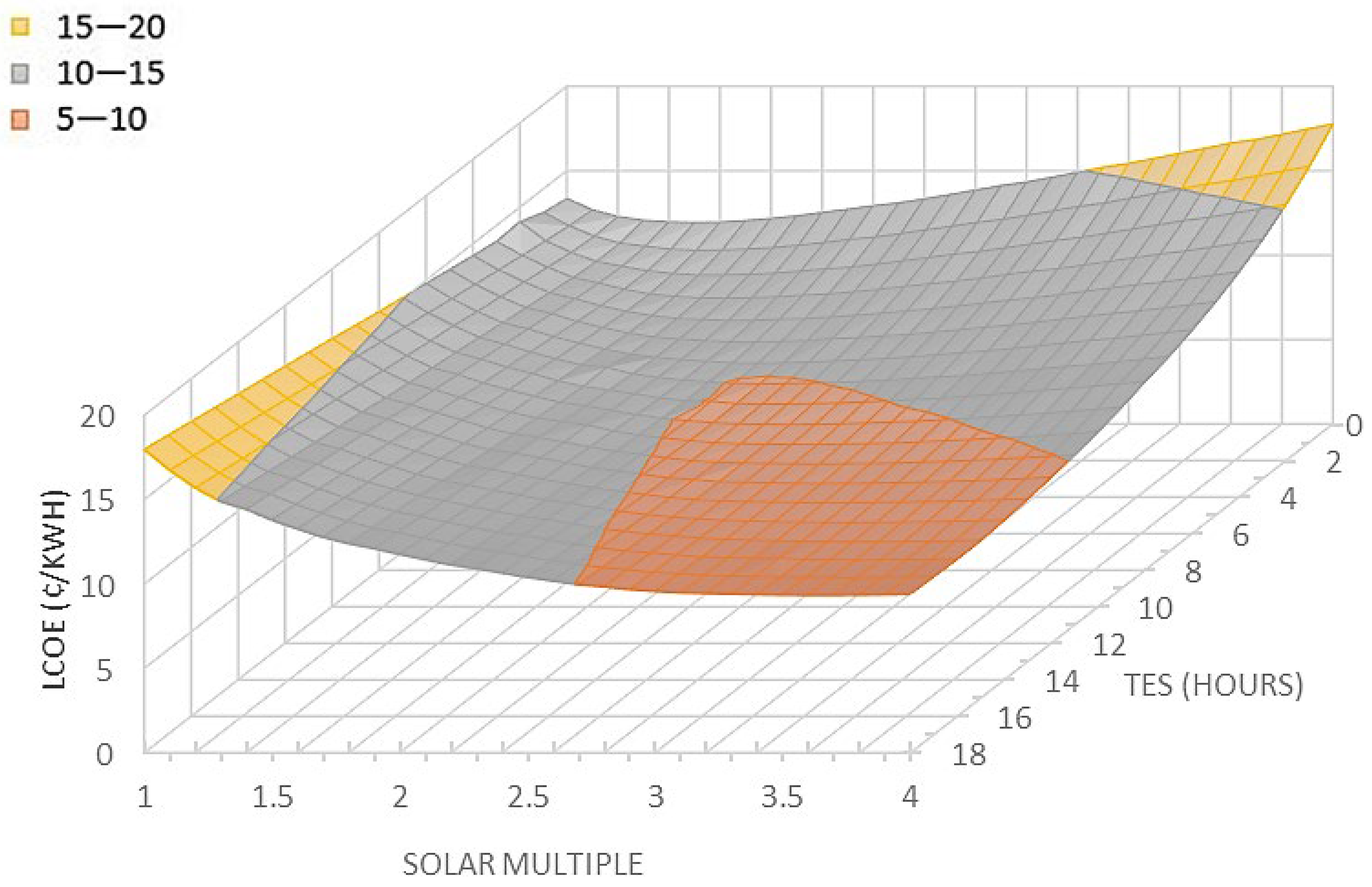
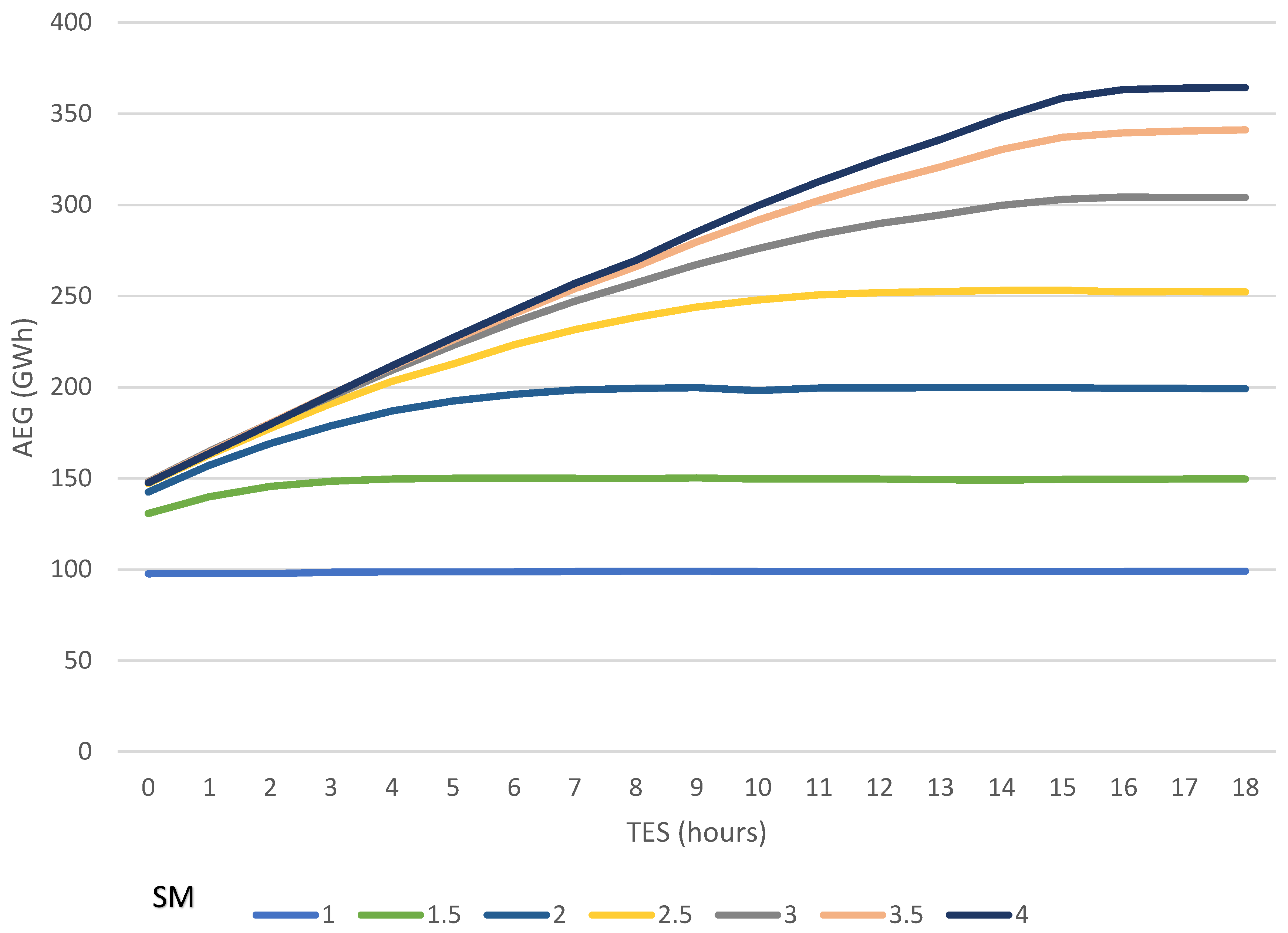




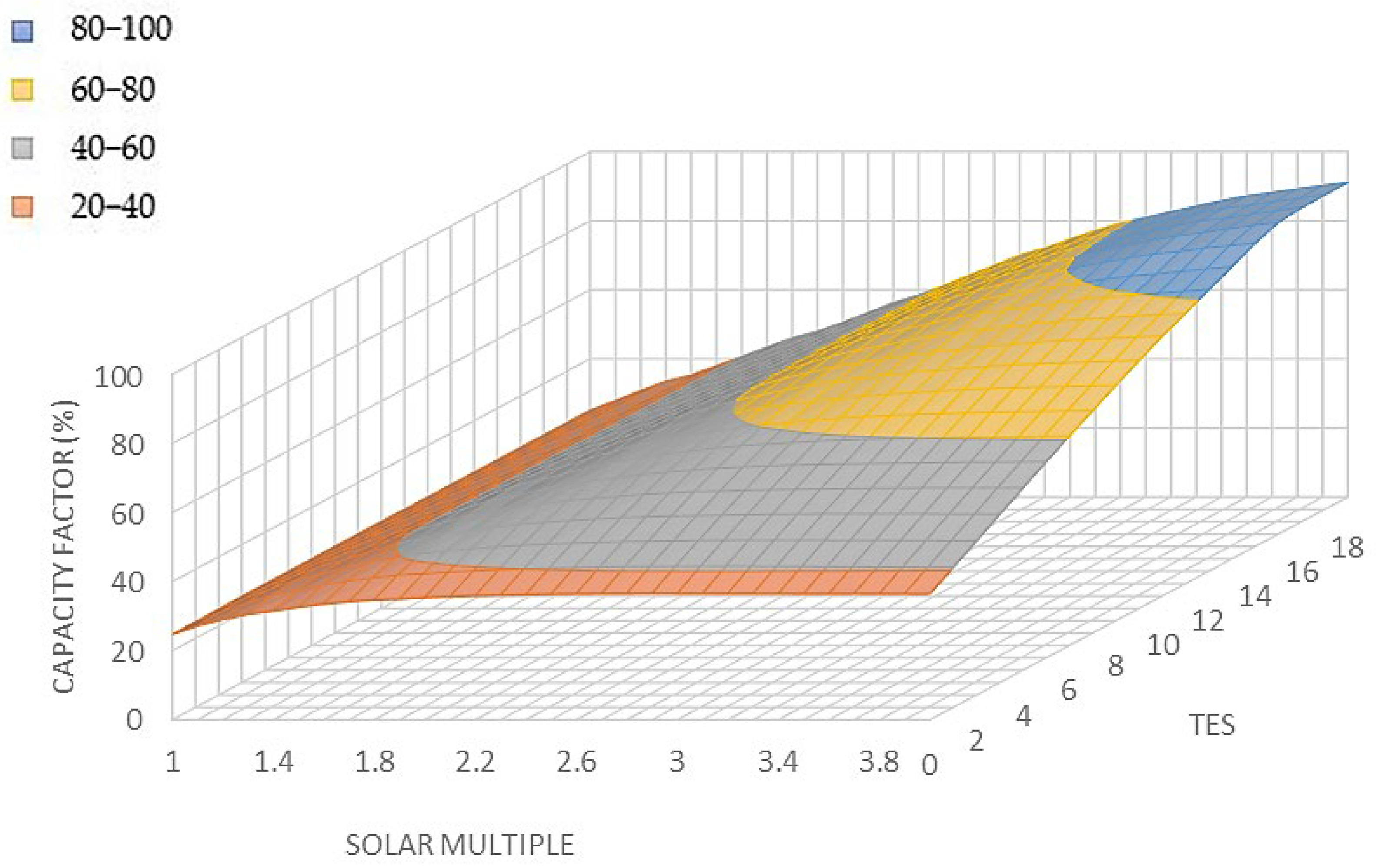

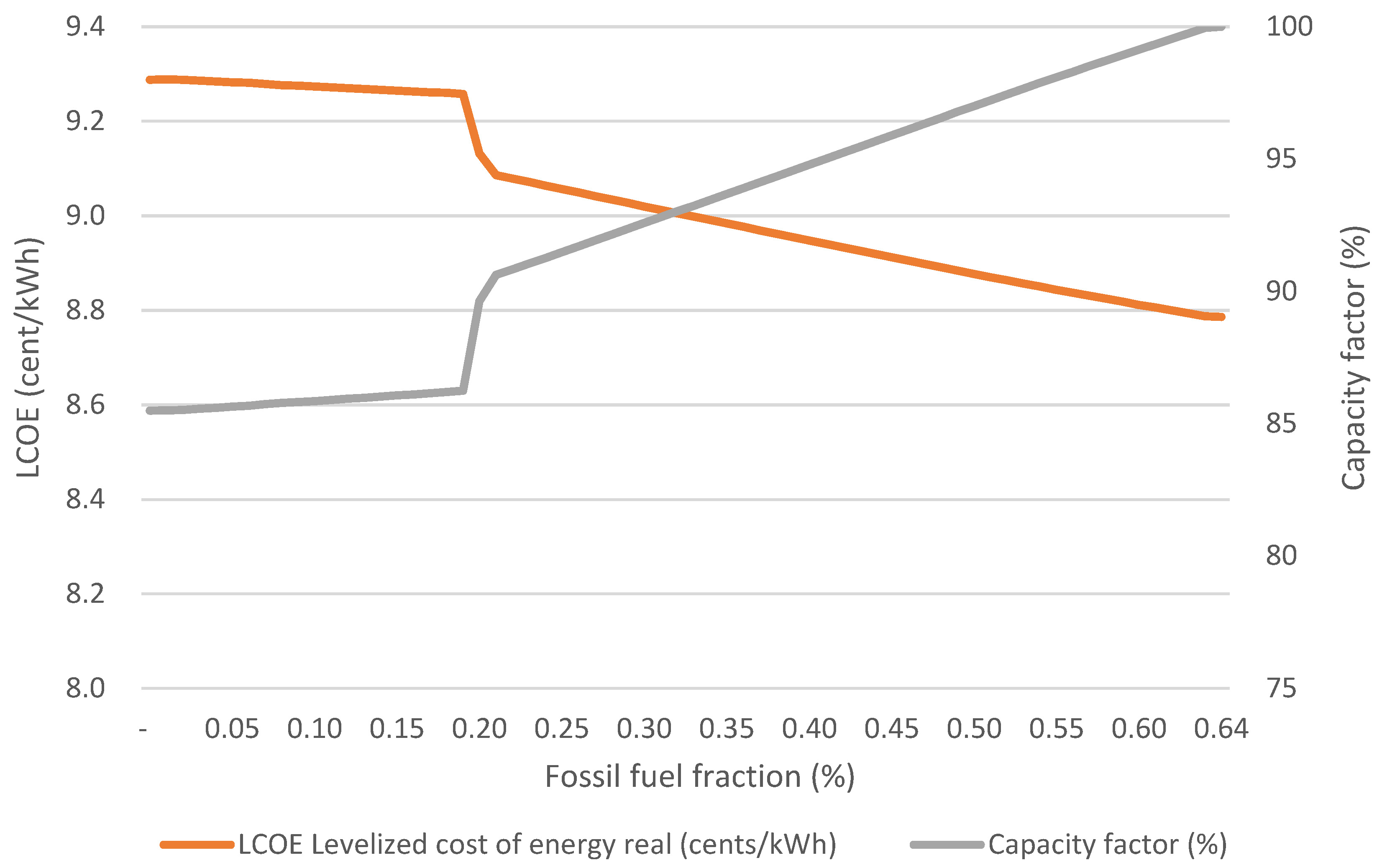

| Power Plant Name | Location | Capacity (MW) | Annual Production (GWh) | HTF | Thermal Storage | Solar Field/Land Area |
|---|---|---|---|---|---|---|
| Dacheng Dunhuang | China–Gansu Province | 50 | 214 | Molten Salt | 2- tank 13 h Molten Salt | 1,270,000 |
| Dhursar | India–Dhursar Rajasthan | 125 | 280 | Water/Steam | None | 340 hectares |
| eCare Solar Thermal Project | Morocco | 1 | 1.6 | Water/Steam | 2 h steam drum | 2 hectares |
| eLLO Solar Thermal Project | France–Llo Pyrénées Orientales | 9 | 20.2 | Water/Steam | 3 h steam drum | 35 hectares 153,000 |
| Puerto Errado 1 Thermosolar | Spain–Calasparra Murcia | 1.4 | 2 | Water/Steam | 1 Ruths Tank thermocline | 5 hectares 18,662 |
| Puerto Errado 2 Thermosolar | Spain–Calasparra Murcia | 30 | 49 | Water/Steam | 0.5 h 1 Ruths Tank thermocline | 70 hectares 302,000 |
| Rende–CSP Plant | Italy–Rende Calabria | 1 | 3 | Diathermic Oil | None | 2 hectares 9780 |
| Augustin Fresnel-1 | Targassonne, France | 0.25 | - | Water/Steam | 0.25 h 1 Ruths Tank thermocline | 400 |
| Huaqiang TeraSolar | Zhangbei Zhangjiakou Hebei China | 15 | 75 | Water/Steam | 14 h Solid State formulated Concrete | 170,000 |
| Lanzhou Dacheng Dunhuang | Dunhuang Jiuquan Gansu China | 10 | 60 | Molten salt | 16 h | 0.6 |
| Subsection | Parameter | Value |
|---|---|---|
| Solar Field | Solar multiple | 1–4 (step of 0.1) |
| DNI at design | 750 | |
| Number of collector modules in a loop | 16 | |
| Number of subfield headers | 2 | |
| Collector | Reflective aperture area | 470.3 |
| Length of collector model | 44.8 m | |
| Length of crossover piping in a loop | 15 m | |
| Piping distance between sequential modules | 1 m | |
| Solar-weighted mirror reflectivity | 0.935 | |
| Dirt on mirror derate | 0.95 | |
| General optical derate | 0.732 | |
| Receiver | Schott PTR 70 | |
| Absorber tube inner diameter | 0.066 m | |
| Absorber tube outer diameter | 0.07 m | |
| Glass envelope inner diameter | 0.115 m | |
| Glass envelope outer diameter | 0.12 m | |
| Power cycle | ||
| Reference output electric power at design condition | 50 | |
| Estimated gross-to-net conversion factor | 120.7 | |
| Estimated net output at design | 45 | |
| Rated cycle conversion efficiency | 39.7% | |
| Boiler operating pressure | 100 bar | |
| Condenser type | Air-cooled | |
| Thermal Storage | ||
| Equivalent full-load thermal storage hours | 0–15 (step of 1) | |
| Height of HTF when tank is full | 20 m | |
| Loss coefficient from the tank | 0.4 |
| Plane | |||||
|---|---|---|---|---|---|
| Transverse incident angle modifier | 0.9896 | 0.044 | −0.0721 | −0.2327 | 0 |
| Longitudinal incident angle modifier | 1.0031 | −0.2259 | 0.5368 | −1.6434 | 0.7222 |
| Cost Type | Description | Value |
|---|---|---|
| Direct capital costs | Site improvement | 20.00 |
| Solar field | 150.00 | |
| HTF system | 47.00 | |
| Thermal energy storage | 32.00 | |
| Fossil backup | 60.00 | |
| Power plant | 1100.00 | |
| Balance of plant | 340.00 | |
| Operation and maintenance costs | Operating cost by capacity | 66 |
| Variable operating cost | 4 | |
| Fossil fuel cost | 4 | |
| Financial parameters | Analysis period | 25 years |
| Inflation rate | 2.5% | |
| Real discount rate | 6.4% |
| Power Plant Subsections | Unit | |
|---|---|---|
| Natural gas combustion | 95 | |
| Solar field | ||
| HTF system | ||
| TES system | ||
| Power block |
| Parameter Type | Solar Field and Performance Parameters | Unit | Dacheng Dunhuang Power Plant | Present Model | Deviation |
|---|---|---|---|---|---|
| Major techno-economic parameter | Turbine capacity | 50 | 50 | ||
| TES capacity | 13 | 13 | |||
| Solar field aperture area | 1.27 | 1.27 | |||
| PPA price in year 1 | 17 | 17 | |||
| Actual and simulated annual performance | Total land area | 3.2 | 3.18 | −1% | |
| Annual energy generated | 214 | 216 | 1% | ||
| Capacity factor | 54.8 | ||||
| Annual water usage | 19,448 | ||||
| Net capital costs | 253 | 257 | 1% | ||
| LCOE | 10 | 9.84 | −2% | ||
| Specific cost | 5064 | 5135 | 1% |
| Parameter Type | Solar Field and Performance Parameters | Unit | Spain Model | Present Model | Deviation |
|---|---|---|---|---|---|
| Solar field input parameters | Number of loops | 50 | 50 | ||
| Solar multiple | 1.72 | 1.72 | |||
| Actual solar field aperture area | 411,000 | 411,000 | |||
| Published and simulated annual performance | Total solar field area | 757,000 | 739,603 | −2% | |
| Solar thermal power | 218 | 207 | −5% | ||
| Annual energy generation | 102 | 102 | 0% | ||
| Capacity factor | 23.4% | 23.7% | 1% | ||
| Annual water usage | 288,207 | ||||
| LCOE | 13.61 | 13.22 | −3% | ||
| Net capital cost | 167 |
| Parameter | Unit | TES = 0 | TES = 18 | Change |
|---|---|---|---|---|
| Annual electricity generated | 131 | 351 | 169% | |
| Capacity factor | 33.2 | 89.1 | 168% | |
| Annual water usage | 11,553 | 29,143 | 152% | |
| LCOE | 11.92 | 9.34 | −22% | |
| Net capital cost | 225 | 513 | 128% |
| Parameter | Unit | Simulated without Storage | Carolina et al. [27] | Simulated Model with Storage | Mihoub et al. [23] |
|---|---|---|---|---|---|
| Location | Duba Saudi Arabia | Seville Spain | Duba Saudi Arabia | Tamanrasset Algeria | |
| Annual DNI | 2723 | 2136 | 2723 | 2759 | |
| Solar multiple | 1.5 | 2 | 3.7 | 2.8 | |
| FFF | 0.25 | ||||
| Annual electricity generated | 131 | 110 | 351 | ||
| Capacity factor | 0.33 | 0.25 | 0.89 | 0.54 | |
| TES capacity | 0 | 0 | 18 | 6 | |
| LCOE | 11.92 | 13.44 | 9.34 | 13.82 | |
| Total cost | 225 | 512 | 319 | ||
| Land use | 170 | 417 | 274 | ||
| Annual water usage | 11,553 | 29,143 |
| TES (hours) | LCOE (¢/kWh) | Optimal SM (-) | Capacity Factor (%) | AEG (MWh) | Cycle Gross Efficiency (%) | Net Capital Cost ($) | Actual Aperture Area | Total Water Consumption |
|---|---|---|---|---|---|---|---|---|
| 0 | 11.92 | 1.5 | 33% | 131,000 | 16% | 225,400,000 | 428,914 | 11,553 |
| 1 | 11.36 | 1.6 | 37% | 145,000 | 17% | 240,308,000 | 459,013 | 12,715 |
| 2 | 10.97 | 1.7 | 40% | 158,000 | 18% | 255,109,000 | 489,112 | 13,797 |
| 3 | 10.68 | 1.9 | 44% | 175,000 | 19% | 276,560,000 | 541,786 | 15,155 |
| 4 | 10.44 | 2 | 47% | 187,000 | 21% | 291,294,000 | 571,885 | 16,157 |
| 5 | 10.25 | 2.2 | 52% | 204,000 | 22% | 314,948,000 | 632,083 | 17,588 |
| 6 | 10.07 | 2.3 | 55% | 214,959 | 23% | 327,442,000 | 654,658 | 18,476 |
| 7 | 9.94 | 2.4 | 58% | 227,000 | 25% | 342,126,000 | 684,757 | 19,430 |
| 8 | 9.82 | 2.5 | 60% | 238,000 | 25% | 356,798,000 | 714,856 | 20,328 |
| 9 | 9.69 | 2.7 | 65% | 256,000 | 27% | 380,502,000 | 775,054 | 21,787 |
| 10 | 9.59 | 2.9 | 69% | 271,836 | 28% | 401,780,000 | 827,728 | 23,106 |
| 11 | 9.52 | 3 | 72% | 283,739 | 30% | 416,234,000 | 857,827 | 24,059 |
| 12 | 9.44 | 3.1 | 75% | 295,802 | 31% | 430,687,000 | 887,926 | 25,014 |
| 13 | 9.38 | 3.2 | 78% | 306,080 | 32% | 442,893,000 | 910,501 | 25,834 |
| 14 | 9.30 | 3.4 | 83% | 325,111 | 34% | 466,335,000 | 970,699 | 27,244 |
| 15 | 9.24 | 3.5 | 86% | 337,018 | 35% | 480,789,000 | 1,000,798 | 28,077 |
| 16 | 9.25 | 3.6 | 88% | 346,011 | 35% | 495,241,000 | 1,030,898 | 28,742 |
| 17 | 9.29 | 3.6 | 88% | 346,822 | 35% | 500,703,000 | 1,030,898 | 28,784 |
| 18 | 9.34 | 3.7 | 89% | 351,378 | 35% | 512,905,000 | 1,053,472 | 29,143 |
| TES (Hours) | Optimal SM (-) | Field Thermal Power Incident | Field Thermal Power Absorbed | Field Thermal Power Produced | Thermal Energy into Storage | Cycle Thermal Power Input |
|---|---|---|---|---|---|---|
| 0 | 1.5 | 1,167,759 | 411,316 | 399,119 | - | 368,502 |
| 1 | 1.6 | 1,249,707 | 439,885 | 428,465 | 29,858 | 406,677 |
| 2 | 1.7 | 1,331,655 | 469,007 | 456,432 | 55,881 | 442,106 |
| 3 | 1.9 | 1,475,064 | 520,093 | 504,957 | 86,961 | 485,372 |
| 4 | 2 | 1,557,012 | 549,152 | 533,062 | 114,577 | 517,978 |
| 5 | 2.2 | 1,720,908 | 607,046 | 589,219 | 151,963 | 563,095 |
| 6 | 2.3 | 1,782,369 | 628,551 | 610,894 | 177,843 | 592,267 |
| 7 | 2.4 | 1,864,317 | 657,592 | 639,000 | 205,883 | 623,154 |
| 8 | 2.5 | 1,946,265 | 686,348 | 667,075 | 232,655 | 652,015 |
| 9 | 2.7 | 2,110,161 | 743,913 | 723,234 | 275,942 | 698,149 |
| 10 | 2.9 | 2,253,570 | 794,860 | 772,377 | 315,390 | 739,872 |
| 11 | 3 | 2,335,518 | 823,845 | 800,400 | 345,824 | 770,679 |
| 12 | 3.1 | 2,417,466 | 852,658 | 828,529 | 376,041 | 801,614 |
| 13 | 3.2 | 2,478,927 | 874,437 | 849,563 | 402,399 | 828,391 |
| 14 | 3.4 | 2,642,823 | 928,750 | 906,123 | 446,833 | 872,581 |
| 15 | 3.5 | 2,724,771 | 959,870 | 933,530 | 473,466 | 899,168 |
| 16 | 3.6 | 2,806,719 | 989,162 | 961,501 | 493,987 | 919,914 |
| 17 | 3.6 | 2,806,719 | 989,069 | 961,508 | 495,531 | 921,343 |
| 18 | 3.7 | 2,868,180 | 1,011,198 | 982,127 | 507,027 | 931,995 |
| Fossil Fill Fraction | LCOE | Annual Fuel Energy | Annual Energy Generation | Capacity Factor | Fossil Fuel Usage | Average Gross Cycle Efficiency |
|---|---|---|---|---|---|---|
| 0 | 9.29 | - | 337 | 85.5 | - | 0.35 |
| 0.1 | 9.27 | 4 | 338 | 85.9 | 13,107 | 0.35 |
| 0.2 | 9.13 | 44 | 353 | 89.6 | 149,647 | 0.41 |
| 0.3 | 9.02 | 72 | 365 | 92.6 | 244,049 | 0.42 |
| 0.4 | 8.95 | 95 | 374 | 94.8 | 322,236 | 0.42 |
| 0.5 | 8.88 | 117 | 382 | 97.0 | 399,308 | 0.42 |
| 0.6 | 8.81 | 139 | 391 | 99.1 | 473,122 | 0.42 |
| 0.64 | 8.79 | 148 | 394 | 100.0 | 503,429 | 0.42 |
| Power Plant Configuration | Water Consumption | Energy Generation | Solar Field | HTF System | TES System | Power Block | Backup System | Total GHG Emissions |
|---|---|---|---|---|---|---|---|---|
| S1 | 11,553 | 131 | 0.36 | 0.2 | - | 0.04 | 0 | 0.0006 |
| S2 | 28,077 | 337 | 0.84 | 0.5 | 0.156 | 0.04 | 0 | 0.16 |
| S3 | 31,791 | 394 | 0.84 | 0.5 | 0.156 | 0.04 | 14,027 | 14,185 |
Disclaimer/Publisher’s Note: The statements, opinions and data contained in all publications are solely those of the individual author(s) and contributor(s) and not of MDPI and/or the editor(s). MDPI and/or the editor(s) disclaim responsibility for any injury to people or property resulting from any ideas, methods, instructions or products referred to in the content. |
© 2024 by the authors. Licensee MDPI, Basel, Switzerland. This article is an open access article distributed under the terms and conditions of the Creative Commons Attribution (CC BY) license (https://creativecommons.org/licenses/by/4.0/).
Share and Cite
Aljudaya, A.; Michailos, S.; Ingham, D.B.; Hughes, K.J.; Ma, L.; Pourkashanian, M. Techno-Economic Assessment of Molten Salt-Based Concentrated Solar Power: Case Study of Linear Fresnel Reflector with a Fossil Fuel Backup under Saudi Arabia’s Climate Conditions. Energies 2024, 17, 2719. https://doi.org/10.3390/en17112719
Aljudaya A, Michailos S, Ingham DB, Hughes KJ, Ma L, Pourkashanian M. Techno-Economic Assessment of Molten Salt-Based Concentrated Solar Power: Case Study of Linear Fresnel Reflector with a Fossil Fuel Backup under Saudi Arabia’s Climate Conditions. Energies. 2024; 17(11):2719. https://doi.org/10.3390/en17112719
Chicago/Turabian StyleAljudaya, Ahmed, Stavros Michailos, Derek B. Ingham, Kevin J. Hughes, Lin Ma, and Mohamed Pourkashanian. 2024. "Techno-Economic Assessment of Molten Salt-Based Concentrated Solar Power: Case Study of Linear Fresnel Reflector with a Fossil Fuel Backup under Saudi Arabia’s Climate Conditions" Energies 17, no. 11: 2719. https://doi.org/10.3390/en17112719
APA StyleAljudaya, A., Michailos, S., Ingham, D. B., Hughes, K. J., Ma, L., & Pourkashanian, M. (2024). Techno-Economic Assessment of Molten Salt-Based Concentrated Solar Power: Case Study of Linear Fresnel Reflector with a Fossil Fuel Backup under Saudi Arabia’s Climate Conditions. Energies, 17(11), 2719. https://doi.org/10.3390/en17112719










